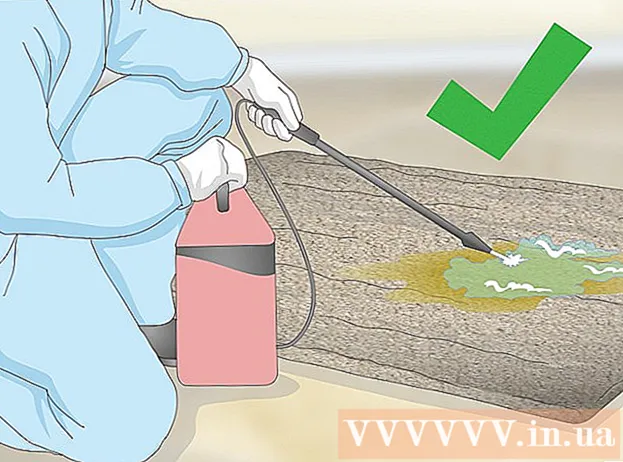Author:
Sara Rhodes
Date Of Creation:
12 February 2021
Update Date:
28 June 2024

Content
- Steps
- Method 1 of 3: Treating ringworm in children with drugs
- Method 2 of 3: Home remedies for ringworm in children
- Method 3 of 3: Get to know the enemy by sight
Literal translation from English ringworm means "ring worm", but in fact, ringworm has nothing to do with worms. This is a fungal disease in which a rash appears in the form of encircling rings. Ringworm causes a lot of discomfort and is most common in children. Learn about treatment options to help your child and localize an infectious disease.
Attention:the information in this article is for informational purposes only. Before using any methods, consult your doctor.
Steps
Method 1 of 3: Treating ringworm in children with drugs
 1 Use over-the-counter creams or powders. Most mild cases can be treated with over-the-counter creams or powders, the main active ingredient of which is clotrimazole, tolnaftate, miconazole, or terbinafine. You can buy these medicines at the pharmacy or ask your pediatrician for advice.
1 Use over-the-counter creams or powders. Most mild cases can be treated with over-the-counter creams or powders, the main active ingredient of which is clotrimazole, tolnaftate, miconazole, or terbinafine. You can buy these medicines at the pharmacy or ask your pediatrician for advice. - The cream is applied to the skin 2-3 times a day for one or two weeks.
- Take the child to the pediatrician if the rash continues to spread and does not get better.
 2 Use oral antifungal medications. If your child's ringworm does not get better after using home remedies or over-the-counter medications, your pediatrician may prescribe an oral antifungal medication. They are much better at dealing with fungus. The drug - in pill or liquid form - spreads throughout the body and kills the fungus.
2 Use oral antifungal medications. If your child's ringworm does not get better after using home remedies or over-the-counter medications, your pediatrician may prescribe an oral antifungal medication. They are much better at dealing with fungus. The drug - in pill or liquid form - spreads throughout the body and kills the fungus. - The child needs to take medication for several weeks.
- Oral medications will be needed for people with ringworm on the scalp or nails. Treatment lasts on average from six weeks to several months.
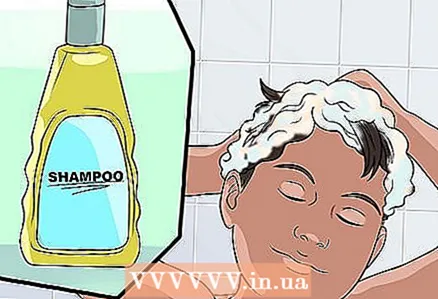 3 Try a special shampoo. If ringworm has infected your baby's scalp, which is common in toddlers and young children, use a shampoo as an adjunct treatment to prevent the spread of the ringworm.
3 Try a special shampoo. If ringworm has infected your baby's scalp, which is common in toddlers and young children, use a shampoo as an adjunct treatment to prevent the spread of the ringworm. - Shampoo should also be used by other family members who are at risk of infection. They also need to be screened for possible signs of ringworm.
 4 Take your child to the doctor. Most of the infections that cause ringworm can be treated with home remedies. Seek medical advice if there is no improvement within one week of starting over-the-counter or herbal medications and the lichen spreads or persists after one month of treatment. Ringworm is uncomfortable and highly contagious, although it is not a health hazard.
4 Take your child to the doctor. Most of the infections that cause ringworm can be treated with home remedies. Seek medical advice if there is no improvement within one week of starting over-the-counter or herbal medications and the lichen spreads or persists after one month of treatment. Ringworm is uncomfortable and highly contagious, although it is not a health hazard. - See your doctor right away if pus comes out of an area infected with shingles.
- You should also see your doctor if ringworm has affected your scalp or appears as more than three patches.
- It should be remembered that ringworm is highly contagious, so before starting treatment, it is necessary to limit the child's close contact with other children. Change your child's bedding daily and make sure he uses a separate towel until the rash disappears from his body.
- Children with ringworm can go to school or daycare after starting treatment. To reduce the risk of infection for people around you, cover the skin affected by the fungus.
Method 2 of 3: Home remedies for ringworm in children
 1 Try garlic. The sulfur components of garlic - ajoene and allicin - have antifungal and bactericidal properties. At least one study has shown that garlic is more effective than terbinafine in treating ringworm.
1 Try garlic. The sulfur components of garlic - ajoene and allicin - have antifungal and bactericidal properties. At least one study has shown that garlic is more effective than terbinafine in treating ringworm. - Grind 2-3 cloves of garlic (or more, depending on the size of the area where the rash is spreading) and mix with a base oil such as castor or almond oil. Apply the mixture to the rash and leave it on for 10-15 minutes, then rinse with warm water. Repeat the procedure 2-3 times a day. Be prepared for the smell to be quite harsh. Change the base oil if irritation occurs, and if that doesn't work, add less garlic to the mixture or try another method.
- Try garlic oil. Add 3-4 drops of garlic oil to 4 tablespoons of base oil. Apply directly to the rash and wash off with warm water after 10-15 minutes. Repeat the procedure up to three times a day.
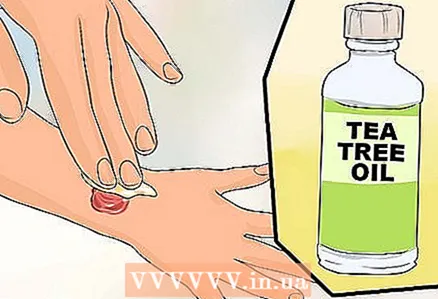 2 Use tea tree oil. From the leaves of the Australian tea tree, oil is made, which, among other useful properties, has an antifungal effect and effectively fights the fungus that provokes the appearance of ringworm. For young children under the age of five, extra precautions should be taken to prevent them from tasting the oil and touching the rash with their tongue.
2 Use tea tree oil. From the leaves of the Australian tea tree, oil is made, which, among other useful properties, has an antifungal effect and effectively fights the fungus that provokes the appearance of ringworm. For young children under the age of five, extra precautions should be taken to prevent them from tasting the oil and touching the rash with their tongue. - Mix tea tree oil with castor or almond oil in a 1: 1 ratio. For example, if you are using 1 teaspoon of tea tree oil, mix it with 1 teaspoon of one of the base oils.
- Apply the mixture to the rash and leave it on for 10-15 minutes, then wash off with warm water. Repeat the procedure 2-3 times a day. In this case, a strong specific odor may appear.
- Use less tea tree oil if irritation develops. For every teaspoon of tea tree oil, add 2 teaspoons of one of the base oils. If that doesn't work, try a different method.
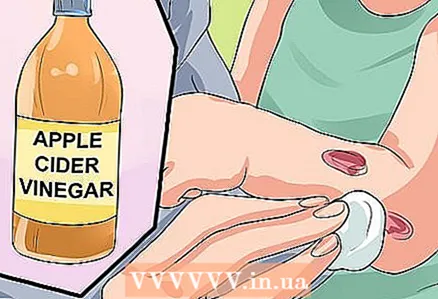 3 Consider using apple cider vinegar. Apple cider vinegar is used to tackle many health problems due to its acidity benefits. Ringworm fungus cannot survive in an acidic environment.
3 Consider using apple cider vinegar. Apple cider vinegar is used to tackle many health problems due to its acidity benefits. Ringworm fungus cannot survive in an acidic environment. - First, apply apple cider vinegar to a small area to test your skin for sensitivity. If you don't respond, use vinegar to treat ringworm.
- Soak a piece of cloth or towel in apple cider vinegar and apply to the area affected by shingles for 30 minutes, then rinse with warm water. Repeat the procedure twice a day. A slight burning sensation may occur upon first use.
 4 Try lavender oil. Lavender oil has antifungal properties and is used in traditional medicine to treat fungal infections and skin conditions. This method is often recommended for children, as most toddlers love the scent of lavender, which in addition has a soothing effect.
4 Try lavender oil. Lavender oil has antifungal properties and is used in traditional medicine to treat fungal infections and skin conditions. This method is often recommended for children, as most toddlers love the scent of lavender, which in addition has a soothing effect. - Mix 1-2 drops of lavender oil with 1 tablespoon of castor oil or jojoba oil. Apply the mixture directly to the area of the rash and let it sit for 10-15 minutes, then rinse with warm water. Repeat the procedure 2-3 times a day.
- Use less lavender oil if irritation occurs. For each tablespoon of one of the base oils, take 1 drop of lavender oil, or add 2 drops of lavender oil to 2-3 tablespoons of castor oil or jojoba oil.
- A recent study has shown efficacy in treating ringworm with a mixture of tea tree oil and lavender oil. To do this, add 2 drops of lavender oil to 2 tablespoons of tea tree oil. Dilute the mixture with 2 tablespoons of base oil (castor oil, almond oil, or jojoba oil). Apply the mixture for 20-30 minutes and rinse with warm water. Repeat 2-3 times a day.
 5 Use coconut oil. Coconut oil has both antifungal and antibacterial and antiviral properties. Antifungal properties are due to the presence of medium-chain fatty acids, which are capable of killing various types of fungi.
5 Use coconut oil. Coconut oil has both antifungal and antibacterial and antiviral properties. Antifungal properties are due to the presence of medium-chain fatty acids, which are capable of killing various types of fungi. - Buy unhydrogenated and unrefined coconut oil.
- Apply coconut oil directly to the affected area or moisten a cotton swab with it and apply it to the affected area. Massage on the coconut oil with a cotton swab and leave overnight.
- Repeat the procedure daily.
Method 3 of 3: Get to know the enemy by sight
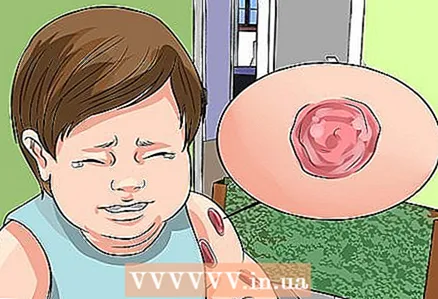 1 Know what ringworm is. Ringworm is a fungal infection of the skin. The name comes from the shingles it causes. Ringworm appears as redness in areas of the skin with a pale area in the center. Ringworm can occur on different parts of the body.
1 Know what ringworm is. Ringworm is a fungal infection of the skin. The name comes from the shingles it causes. Ringworm appears as redness in areas of the skin with a pale area in the center. Ringworm can occur on different parts of the body. - In the scalp, this fungal infection manifests itself as red spots on which hair falls out and the skin is flaky.
- To refer to ringworm in medicine, the term trichophytosis is used. In Latin, ringworm on the body is called tinea corporis, while lichen in the head area is called tinea capitis... A fungal infection in the genital area is known as tinea cruris, and in the area of the foot - tinea pedis.
- Ringworm is most often caused by fungal activity. Trichophyton rubrum... Other fungi that cause ringworm are Microsporum and Epidermophyton.
 2 Investigate sources of ringworm infection. Ringworm is most common in children, especially those under the age of 15. However, no one is immune from the disease, since this infection is very contagious.
2 Investigate sources of ringworm infection. Ringworm is most common in children, especially those under the age of 15. However, no one is immune from the disease, since this infection is very contagious. - Risk factors for ringworm are a humid environment, close contact with an infected person, and participation in sports activities that involve close contact and wearing tight clothing.
- Ringworm also affects cats and dogs, which in turn is transmitted to humans.
 3 Know the symptoms of ringworm. This infection has a distinct form in the form of reddish ring-shaped spots along the edges, pale in the center. The affected area of skin is often itchy and, in some cases, swollen.
3 Know the symptoms of ringworm. This infection has a distinct form in the form of reddish ring-shaped spots along the edges, pale in the center. The affected area of skin is often itchy and, in some cases, swollen. - The round, reddish edges of the lesion may be slightly raised, and the rash is often scaly.
- Itching causes scratching of the skin, which can lead to scarring.

